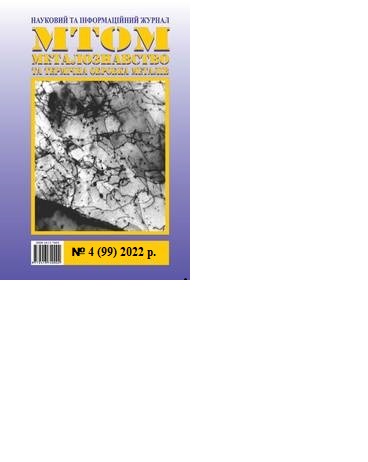STRUCTURE AND PHYSICAL-MECHANICAL PROPERTIES OF ELECTROCRYSTALLISED COATINGS OF Ni−P ALLOY
DOI:
https://doi.org/10.30838/J.PMHTM.2413.271222.40.909Keywords:
electrocrystallized coatings, alloy, surface morphology, microhardness, reflectivityAbstract
The purpose of the research. Ni−P electrolytic alloy coated products are of great interest in many industries such as electronics (magnetic recording devices), oil and gas industry, medical equipment manufacturing, catalyst manufacturing. In this connection, the task of determining rational deposition modes of electrocrystallized coatings based on Ni−P alloy with increased technological and operational properties and researching their structure arises. In addition, there is a need to replace chrome electrocoatings, which, along with very high indicators of mechanical, protective and decorative properties, are obtained from toxic electrolytes that are dangerous of human life and health. Materials and methodology. In this work, electroplating of Ni−P alloy, obtained from a new electrolyte developed by us, was proposed as a replacement for chromium. Modes of obtaining high-quality electrocoating with Ni−P alloy have been identified, in which the best deposition characteristics, mechanical and decorative properties have been determined. Results. The effect of electrolysis parameters on current output, deposition rate, microhardness, surface morphology and reflectivity of electrocrystallized coatings was investigated. It was also found that the addition of phosphorus ions to the nickel plating electrolyte leads to amorphization of Ni−P alloy deposits. Scientific novelty. The influence of the deposition regime on the formation of the internal structure and surface morphology of Ni−P electrolytic coatings obtained from the electrolyte developed by the authors was studied. Conclusions. The patterns of electrodeposition of Ni−P alloy coatings were studied, and the factors influencing the formation of structure and properties were identified. It was established that the addition of phosphorus ions to the nickel plating electrolyte leads to amorphization of coatings, an increase in microhardness and reflectivity. On the basis of the analysis of the received data, the optimal conditions of electrocrystallization, under which it is possible to obtain a coating with specified physical and mechanical properties, are determined.

Downloads
Published
Issue
Section
License
Authors that are published in this journal agree to follow the conditions:
Authors reserve the right to the authorship of his work and cede the right to the journal of first publication of this work on conditions of the license under the Creative Commons Attribution License, which allows others to distribute it freely with the obligatory reference to the author of the original work and the first publication of the work in this journal.
